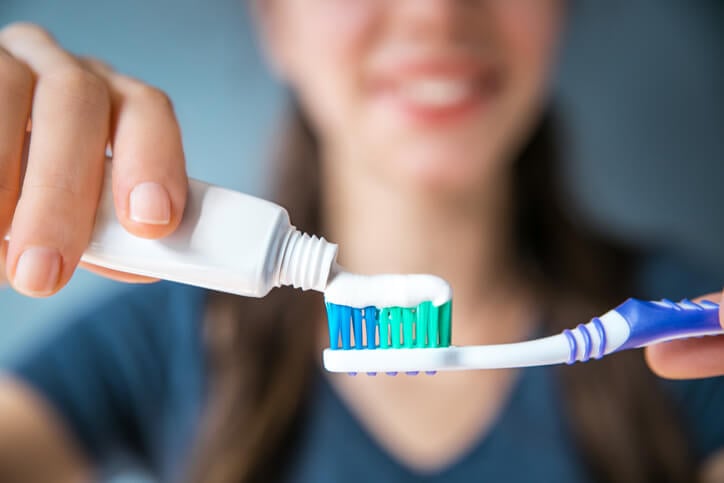Brushing your teeth with a product designed to make your mouth feel fresh is a pleasure. But from a practical standpoint, that minty paste isn’t as necessary as you think. You can remove food debris and plaque from your teeth without toothpaste.
Plaque is the primary cause of cavities and gum disease. If you don’t consistently remove plaque from your teeth, it can harden into an even sticker substance called tartar, which provides a perfect environment for bacteria colonies to grow under your gums and on your teeth.
Can I Brush My Teeth Without Toothpaste?
One of the best ways to control plaque is by brushing your teeth thoroughly at least twice a day. However, you don’t necessarily need toothpaste to do this. Using a soft toothbrush and good brushing techniques can remove plaque. Flossing, limiting sugary food and drinks, regular checkups, and professional cleanings should also keep your teeth in top shape.
Regular preventive care, including professional cleanings, can reduce the chance of serious dental health issues. Dental insurance often pays 100% of the cost of dental checkups, knowing that investing in preventive care can enable customers to avoid costly restorative treatments over time.
Why You Might Want to Use Toothpaste
While you can clean your teeth without toothpaste, you still might want to use it. Here are some of the reasons:
- Toothpaste tastes good. Toothpaste flavors like mint, banana, basil, bubblegum, coffee, curry, eggplant, honey, lemon, peach, pumpkin pudding, and yogurt offer a taste you never expected on your toothbrush.
- Most toothpaste contains fluoride, and dentists agree that topical fluoride treatments help keep tooth enamel strong and cavity-resistant.
- Toothpaste can help address dental concerns such as sensitive teeth, whitening, early tooth decay, and gum disease issues. Ask your dentist or dental hygienist for recommendations on the right toothpaste for your teeth.
What’s in Toothpaste?
So what exactly is in toothpaste? Standard (non-organic) toothpaste typically contains a set of ingredients that include:
- Abrasives to clean bacterial film and debris from your teeth: Examples include calcium carbonate, dehydrated silica gels, hydrated aluminum oxides, magnesium carbonate, phosphate salts, and silicates. Silica is the whitening ingredient in most whitening toothpastes.
- Detergents for cleaning and the foamy lather we expect from toothpaste. Examples include sodium lauryl sulfate and sodium lauroyl sarcosinate.
- Fluoride – All toothpastes accepted by the American Dental Association (ADA) contain fluoride, even organic ones.
- Flavor including sweeteners such as saccharine. No ADA-accepted toothpaste contains sugar.
- Treatment additives such as tetrasodium pyrophosphate for tartar control, potassium nitrate or strontium chloride to reduce tooth sensitivity, stannous fluoride and triclosan for reducing gum inflammation and removing plaque.
- Humectants to keep the toothpaste moist. Examples include glycerol, propylene, glycol, and sorbitol.
- Binders to stabilize the toothpaste formula. Examples include mineral colloids, natural gums, seaweed colloids, or synthetic cellulose.
Organic toothpaste tends to be free of paraben, sulfate, sodium lauryl sulfate, and artificial colors, flavors, or sweeteners. It may contain natural preservatives instead of EDTA, formaldehyde, and paraben. If you tend to get a lot of small pimples, rashes around your lips, or canker sores inside your mouth, you may want to try a toothpaste that doesn’t contain sodium lauryl sulfate.
How Long Have People Been Using Toothpaste?
The first known toothpaste recipe dates back to 5,000 B.C. Egyptians used a mixture of crushed rock salt, iris flowers, pepper, and mint to clean their teeth. Historians have also found evidence that the Greeks and Romans used a mixture of crushed bone and oyster shells as toothpaste. Around 3,500-3,000 B.C., a mix of ginseng, mints, and salt was the preferred recipe in China.
In 1873, Colgate released the first mass-produced toothpaste. It was called Crème Dentifrice, and was sold in a jar. By 1896, the name had changed to Colgate Dental Cream and it was packaged in collapsible tubes. Fluoride was introduced in 1914 and was quickly added to the majority of toothpastes on the market.
The Importance of Professional Dental Cleanings
No matter what type of toothpaste you prefer, good oral hygiene and regular dental care is the best way to keep your smile healthy. With a consistent oral hygiene routine, you can remove most of the plaque from your teeth on your own, but professional cleanings are essential to rid your mouth of plaque that you can’t remove at home.
Dental savings plans can help lower the cost of preventive dental care like check-ups and cleanings, as well as any restorative or emergency care you experience. To find out more about dental savings plans, you can call us at 1-833-735-0399. We can answer any questions you have about how a dental savings plan can help provide affordable access to professional cleanings and more.
